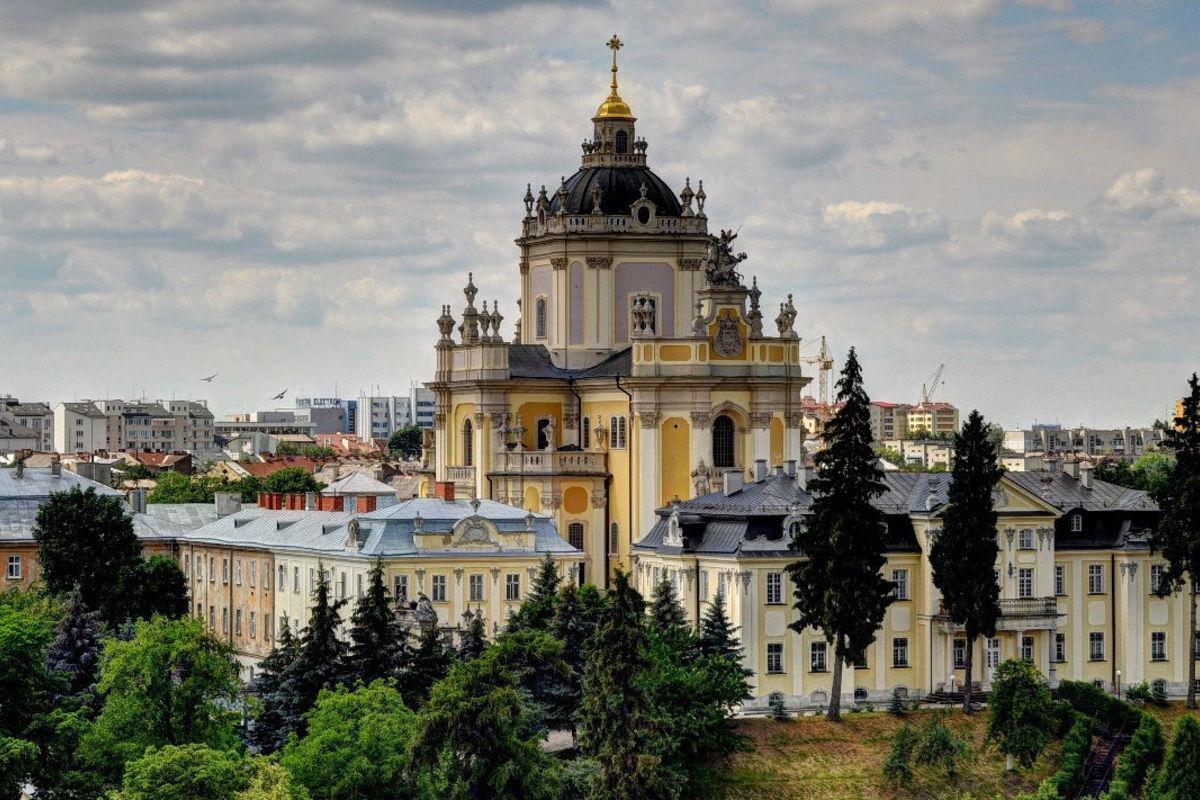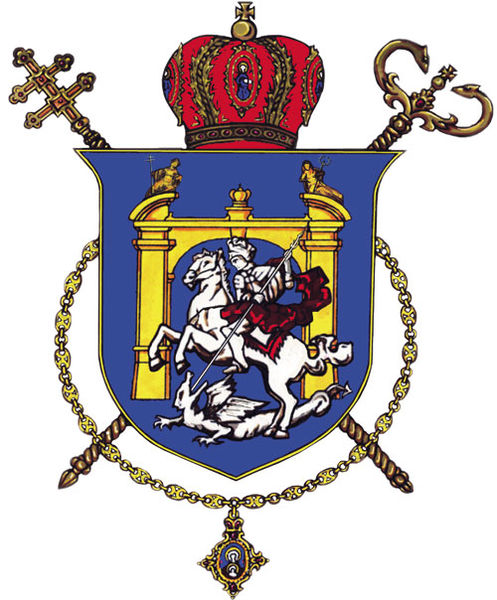Archeparchy of Lviv

About
The archeparchy of Lviv is located in the western part of Ukraine in the Lviv region with its seat in Lviv city. The city of Lviv (including Vynnyky, Briukhovychi, and Rudne), Zolochiv, Pustomyty, and Yavoriv districts of Lviv region belong to the archeparchy of Lviv. Thus, the territory of the archeparchy is 3 774,5 km2.
According to the statistical data from 2018, the population of the archeparchy is 1 063 046 people. There are 356 settlements on the territory of the archeparchy.
 Coat of arms of the archeparchy of Lviv
Coat of arms of the archeparchy of Lviv
The archeparchy of Lviv is divided into 18 deaneries:
- Halych deanery
- Zaliznychnyi deanery
- Lychakivskyi deanery
- Sykhivskyi deanery
- Frankivskyi deanery
- Shevchenkivskyi deanery
- Hlynyanskyi deanery
- Zolochiv deanery
- Pomoryany deanery
- Vynnyky deanery
- Zvenyhorodka deanery
- Pustomyty deanery
- Sokilnyky deanery
- Krakovets deanery
- Nemyriv deanery
- Novoyavorivsk deanery
- Yavoriv deanery
- Yaniv deanery
311 parishes belong to the archeparchy. Among the clergy, there are 442 priests of whom 52 are outside the archeparchy.
Also, the archeparchy of Lviv has about 15 deacons of whom 1 carries out his ministry outside the eparchy.
On the territory of the eparchy, there are eight male and fifteen female institutions of consecrated life. The former has 18 and the latter 35 monasteries in the area.
Lviv Theological Seminary of Holy Spirit, Basilian Institute of Philosophical and Theological Studies named after Joseph Velamin-Rutski in Briukhovychi, and the Ukrainian Catholic University are educational institutions of the archeparchy of Lviv.
Location
Bishops
Since November 10, 2005, the Reverend Bishop Ihor Vozniak has been the ruling archbishop of the archeparchy of Lviv. And the Reverend Bishop Volodymyr Hrutsa has been Auxiliary bishop of Lviv since January 14, 2016.
A cathedral of the archeparchy of Lviv is St. George’s Cathedral.
History
The eparchy of Lviv was established in 1539. Its first bishop was titular Bishop of Halych Metropolis, bishop of Lviv and Kamianets-Podilskyi Makaryi Tuchapskyi (1540–1549) who was ordained by Kyiv Metropolitan Macarius (1535–1556).
Until 1414, the seat of the bishop had been in Halych. That is why it was called the eparchy of Halych, which was first mentioned in chronicle sources in 1156 when it was headed by Bishop Kozma, whose predecessor was Bishop Oleksiy. Most historians consider 1137 the actual year of the establishment of the eparchy of Halych when it was separated from the eparchy of Volodymyr.
Until 1414, the borders of the eparchy of Halych were the same as those of the newly created eparchy of Lviv in 1539. The eparchy of Lviv was created on the territory of the prior eparchy of Halych. In historiography to define the Lviv eparchy, it is common to use the title the eparchy of Halych-Lviv to emphasize the fact that the Lviv eparchy is the successor of the Halych one. The latter had the status of the central eparchy of the Halych Metropolis in the periods of 1302–1332, 1337–1347, and 1371–1401. It included the eparchies of Przemyśl, Volodymyr, Kholm, Lutsk, Turov, and from 1340 also Polotsk.
From 1414 to 1539, the Halych eparchy was transformed into the Viceroyalty of the Kyiv Metropolitan assigned vicars and not the bishop to the viceroyalty. On October 23, 1539, the status of Metropolis was renewed and Makaryi Tuchapskyi who had been a vicar of the Kyiv Metropolitan was ordained as a bishop on February 22, 1540, with the seat in Lviv.
As of 1772, the eparchy of Lviv had 2504 parishes.
On February 24, 1807, the Metropolis of Halych was renewed and the Lviv episcopate was given the status of the archeparchy. Lviv became a seat of Halych Metropolitans. The first Metropolitan was Kyr Antin Anhelovych (1807–1814) who initiated the creation of the eparchy of Stanislaviv (today Ivano-Frankivsk). However, only in 1885, it was possible to realize his idea when the bishop of the eparchy was Sylvester Sembratovych.
In 1832 the territory of the eparchy was divided into 9 counties which included 73 deaneries. In 1843 it was still 9 counties, but 29 deaneries were canceled and new 4 ones created thus, in total it was 48 deaneries. In 1871 because of the Partition, one new deanery was established.
In 1885 twenty deaneries (442 parishes, 735 960 faithful) of the archeparchy of Lviv were given to the eparchy of Stanislav. In 1890 one of the twenty deaneries, Halych deanery (20 parishes), became part of the Lviv eparchy again, which at the same time sent 5 parishes to the eparchy of Stanislaviv.
In 1907 the number of deaneries reached 52 and in 1939 there were 54 deaneries as a part of 5 counties.
From 1946 to 1989 the archeparchy of Lviv as a whole Ukrainian Greek Catholic Church was forced to operate underground.
On August 19, 1990, Archbishop Volodymyr Sternyuk celebrated the first Episcopal Divine Liturgy in the return to the UGCC St. George’s Cathedral in Lviv. This significantly strengthened the faithful and gave another inspiration for the return of many shrines of the UGCC.
On March 30, 1991, His Eminent Beatitude
Myroslav Ivan Lubachivsky Cardinal, Major Archbishop of Lviv returned from Rome to his Metropolitan place in Lviv. Thus, it was the beginning of the restoration of church structures of the UGCC on the territory of Ukraine.
To organize the territories and for the needs of pastoral work, the Synod of Bishops of the UGCC, which took place in May 1992, decided to create four new eparchies. With the blessing of Holy Father John Paul II, this decision was officially proclaimed on July 12, 1993. In this way from the archeparchy of Lviv, it was separated and created the eparchies of Zboriv, Sambir-Drohobych, and Ternopil.
The Synod of Bishops that took place on July 16–21, 2000, made a new partition of the territory of the Supreme Archeparchy and separated nineteen deaneries from the archeparchy of Lviv. From twelve deaneries a new eparchy of Stryi was created and the other seven entered the reorganized eparchy of Sokal.
On November 29, 2011, the establishment of the Lviv Metropolitanate of the UGCC was solemnly proclaimed. Archbishop Kyr Ihor Vozniak was elected as the Metropolitan of Lviv.
The Lviv Metropolis included: the Lviv archeparchy, Sokal-Zhovkva, Stryj, and Sambir-Drohobych eparchies.
Shrines
Talking about pilgrimage sites, it is important to mention Maria’s Spiritual Center in Stradch village (Yavoriv district, Lviv region) where there is a miraculous icon of the Mother of God of the Immovable Wall (a copy written after WWII) and a miraculous icon of the Dormition of the Blessed Virgin Mary (XVIII c.), Jerusalem Christ’s Way, the burial of the Blessed Martyr Nicholas Konrad and his blessed singer Volodymyr Pryima.
Besides this, it is worth mentioning the Church of Holy Maccabean Martyrs above the miraculous spring in Novosilka village (Pustomyty district, Lviv region). Also, it is impossible to avoid a native village of the Metropolitan Andrey Sheptytsky called Prylbychi (Yavoriv district, Lviv region) where the tomb of the Sheptytskyi family, the old church of the Blessed Virgin Mary, the museum of the Metropolitan Andrey, are located.
Also, many shrines of the archeparchy of Lviv are in the city of Lviv. These are the Bernardine church where Derevnya miraculous icon of the Mother of God (second half of XVIII c.) and relics of the patron of the church, St. Andrew the First-Called, are placed, a unique wood church of Holy Trinity from XVII c., the church of the Blessed martyr Josaphat where are relics of Blessed Mykolay Charnetsky, a chapel of Blessed martyrs Olimpiya and Lavrentiya where are the relics of the patrons of the chapel, a museum of Blessed martyr Vasyl Velychkovskyi with his relics, a church of the Nativity of the Blessed Virgin Mary where are relics of Blessed martyr Hryhoriy Lakota, Saints Josaphat and Panteleimon.
Also, among the miraculous icons of the archeparchy, there is Lisok miraculous icon of Admiration in St. George Church in Yavoriv (Lviv region), a miraculous icon of the Crucifix of Christ (middle XVII c.) in Hlynyany village (Zolochiv district, Lviv region), Pomoryany miraculous icon of the Blessed Virgin Mary (middle XIX c.) in the Cathedral of the Mother of God in Pomoryany village (Zolochiv district, Lviv region), a copy of Lisok miraculous icon of the Blessed Virgin Mary in the church of the Position of the Honest Belt of the Blessed Virgin in Lisok Chernylyavskyi (Yavoriv district, Lviv region), a copy of Holubytsia miraculous icon of the Mother of God (1724) in the monastery of Ascension of Christ in Zolochiv (Lviv region).
Contacts
Address: sq. St. Yura, 5, Lviv 79000, Ukraine
Phone/fax: +380 (32) 261-08-94; +380 (67) 320-62-82
Email: [email protected]
Website: ugcc.lviv.ua